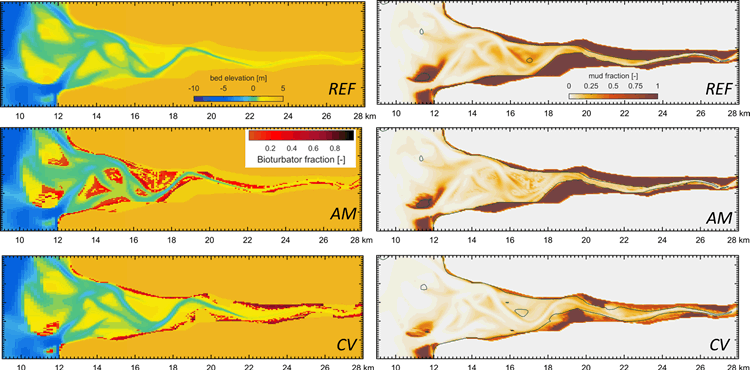M.Z.M Brückner1*, C.S. Schwarz1, A. W. Baar2 & M.G. Kleinhans1
1 Dep. Physical Geography, Utrecht University,
2 Energy and Environment Institute, University of Hull
Introduction
Macrobenthic species that live within or on top of estuarine sediments can destabilize local mud deposits through their bioturbating activities. Resulting enhanced sediment availability will affect redistribution of fines and hence large-scale morphological change. However, various species are expected to affect this feedback differently, leading to distinct morphological features that determine the functioning and management of estuaries.
Methods
To quantify this biological control on the morphological development of estuaries, we numerically model two contrasting bioturbating species present in NW-Europe by means of our novel literature-based eco-morphodynamic model. We couple dynamic macrobenthic growth of two generic bioturbators, loosely based on A. marina and C. volutator, with an idealized hydro-morphodynamic domain parameterized in Delft3D that includes sand and mud. Species 1 is characterized by low abundance in mud and low bioturbation potential while Species 2 prefers large mud fractions and has a high bioturbation potential. Monthly coupling between the bioturbation model and Delft3D leads to emerging dynamic patterns of both bioturbators and mud deposition.
Results
We find significant effects of both bioturbators on local mud accumulation and bed elevation change, leading to a large-scale reduction in deposited mud and gently sloped intertidal floodplains in the confined part of the estuary. In turn, the species-dependent reduction of mud content redefines their habitat and leads to constricted species abundances. Our results show that species-specific macrobenthic bioturbation determines large-scale morphological change through mud redistribution. This suggests that macrobenthic species have subtly changed estuarine morphology through space and time, depending on their distribution and composition.

Figure 1 Bioturbator abundance (A) and related mud distribution (B) for two contrasting bioturbating species. Species 1 is abundant in the more dynamic parts of the estuary while species 2 mainly survives at the edges of the estuary. A reduction in mud fraction induced by species 2 leads to a less mud at the shores and a wider central part of the estuary.
I. Surname1*, F.N. Another-Surname2 , Y. Next-Surname2
1 University Name, Country; 2 Organization Name, Country
* Corresponding author: mail.name@organization.org


